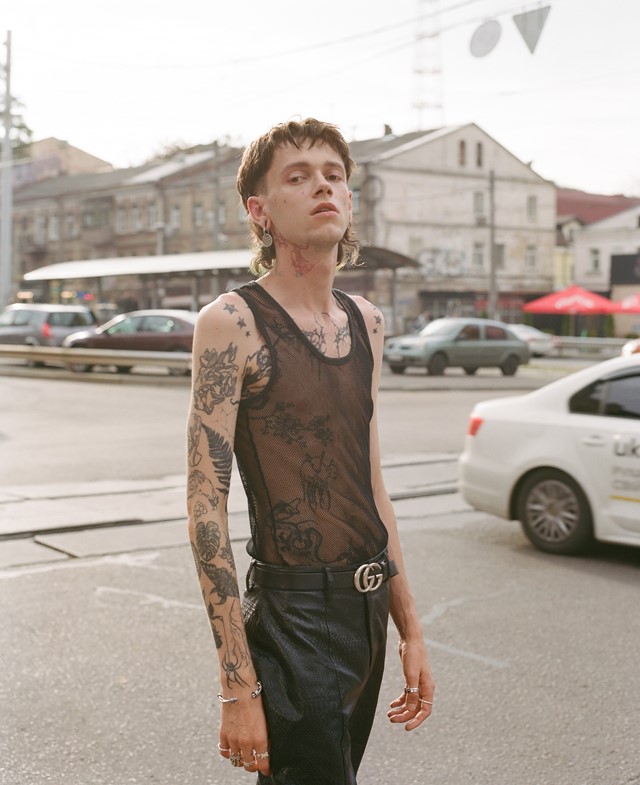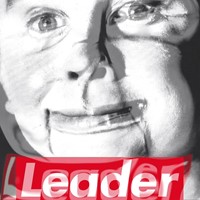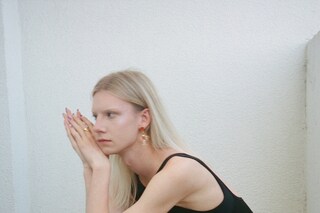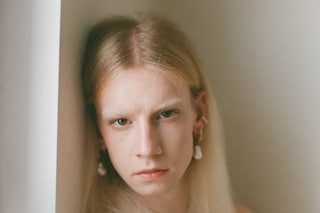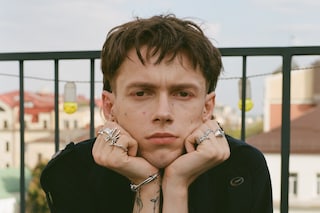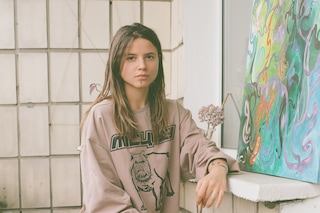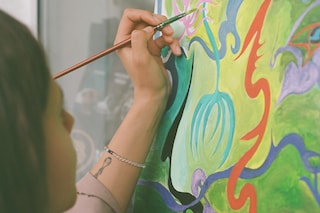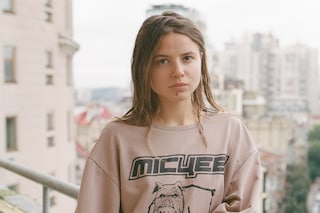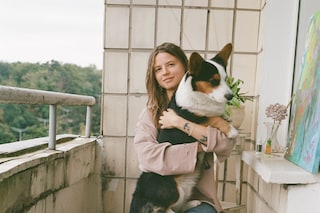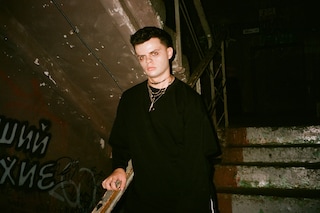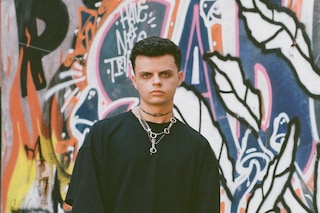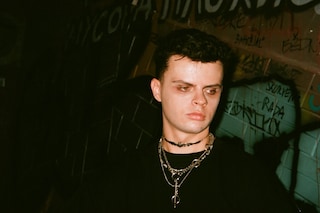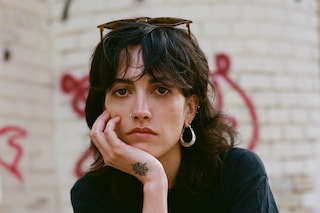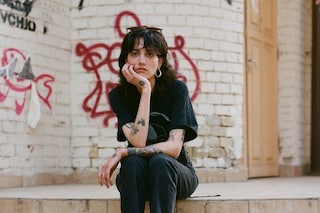Photographer Marcus Lister’s ongoing project shares the stories of young Ukrainian artists, drag queens, DJs, and dancers making art and organising festivals, raves, and balls during wartime
Last September, photographer Marcus Lister and videographer Oonagh Shaw embarked on a journey to Ukraine. Having both spent time in Kyiv before the Russian invasion, they were drawn back to the city, compelled by a sense of urgency to document and share the experiences of the creative community that had felt so vibrant and potent on previous visits. “We keenly recognised the imperative to cast a spotlight on the experiences of young individuals living amidst perpetual fear, uncertainty and the looming threat [of violence],” Lister tells Dazed.
Prior to the 2022 Russian invasion, Lister had fallen in love with Kyiv for its dynamic culture of creativity and art; its ”underground clubs, bars, record stores, fashion, flea markets and galleries”. Continuing to follow creatives and venues on social media throughout the ensuing conflict, he’d observed clubs such as K41 and Closer hosting events and festivals in Kyiv – “almost as a defiant stance against the Russian state”. With Shaw as co-producuer and videographer, he conceived the idea of returning to the city in 2023 to meet the emerging artists, photographers, DJs, and designers organising festivals, raves, and balls during wartime. The pair wanted to not only take portraits of the young creatives, but to record their first-hand accounts of their experiences. Lister tells Dazed it felt like an essential “act of solidarity”.
Keen for each portrait to be as true to the individual as possible, Lister approached every session as an opportunity to get to know each sitter. “I encouraged each person to choose a location that felt most natural for their portrait – whether it be their homes, local parks, or studios,” he says. “My approach was to simply spend time with each person, learning from them about life in Ukraine and what it’s like to be a creative in the city.”
While Lister sees this as an ongoing project and intends to return to Kyiv later this year, below, we meet six of the emerging creatives already featured in the series...
“I’m 20 years old and a member of the ballroom, Kiki house of Extaz. The ballroom scene, for me, is the place where I can be myself and realise my desires. Ballroom represents freedom, the defence of rights, and equality. In Ukraine, the ballroom scene continues to evolve and develop even during the war. We create moments and find joy in them. Ballroom and houses are more than just dancing; they are culture, love, and a fight.
“As a non-binary person and drag queen, I’ve witnessed the impact of the war on artists leaving the country. Despite this, there’s a resilient community in Ukraine creating incredible events like concerts, galleries, and fundraisers for the army. The war has significantly affected mental health, causing fear, stress, disappointment, shattered dreams, and depression. To me, Kyiv represents an unbreakable fortress, housing free and independent individuals. It’s the heart of the country.”
“I’m a simple boy who was bullied at school. [Then] there came a day when I realised I needed to redirect the course of this world. So, I began drawing attention to myself. I live for music and I like to collect images, especially at raves.
“My personal perspective [of the war] is rooted in what I witnessed here in the initial months... Imagine everything shuttered in your neighbourhood — no lights, no people. Fear and silence prevailed. At times, it seemed that everything had turned to grey and nothing could infuse colour into this monotonous routine. However, people began returning, quietly and delicately. Flower shops and beauty salons reopened. People emerged from their despondency and commenced rebuilding the country’s economy. We still have a long way to go, so we’ve clenched our fists and continue the fight for justice and our own home.
“To me, Kyiv embodies the simple pleasure of strolling from one bank to the other – alas, hindered by the current curfew – and it's disheartening to realise that I've forgotten the feeling of nighttime walks in the city.”
“I’m 25 and I [first] moved to Kyiv when I was 17. I’m a multidisciplinary artist and I have a clothing brand. The war made a lot of people go move outside of the country or join the military forces, but many of my artist friends stayed and kept on working. But I feel like a lot of new talents emerged or felt more brave to express the voice. People definitely became more active.
“To me, the main obstacle was – and still is – how to respond to [war] emotionally, how to process all of it, how to find way to support people who are direct victims of the invasion. In terms of the practical side of life, it was not that hard for me to adapt. I didn’t have a job, so I couldn’t lose one. I had some money put aside, so for the first months of the invasion, I could live with it. But it was way harder for a lot of people around me. Overall, I feel like this city has this raw and unique creativity that you rarely find. I am happy to live in the same place with so many talented people and have the chance to co-create with them.”
“I'm Kostiantyn, 26, and I made Kyiv my home five years ago. [This city] fuels my creativity as a Creative and Art Director in advertising. I'm not just a director; I'm also a photographer, capturing commercial projects and expressing my artistic side. During the war, I’ve also channelled my energy into social projects, organising meetings and fundraising to provide military equipment for our soldiers.
“The war touched every one of us. Some shifted their career paths, while others decided to leave. In almost two years, we’ve become adept at facing any challenge. What’s striking is the growing unity within the creative community, a bond stronger than ever. We're all driven by a common purpose.
“The most profound challenge I faced was the loss of friends and loved ones who gave their lives in defence of our freedom. These were the same people I shared simple moments with, sipping tea in the kitchen just a week before the war, dreaming of a shared future.”
“I’m 24. I was born here and have been living in Kyiv my whole life. I try to balance between creative and ‘normal stable’ jobs. So I’m a dancer, DJ, translator, and sometimes I work as a copywriter. I also produce beats and remixes for the ba’s my other huge interest – I put a lot of effort into the development of ballroom culture in Ukraine and I love organising ballroom events. It has been helping my mental health a lot for the last two years and I think many people from our community can say the same. It’s not just entertainment and a space to gather our ballroom community but a way to collect donations that will go to LGBTQ+ soldiers and detachments where they serve. It has become a usual practice for many events in Ukraine because we always remember that we can have them thanks to the people who protect us. It may seem strange that we have parties during the war but constant grief and frustration won’t help us to win. This helps us and our economy to function and it also gives us little moments of happiness which we need more than ever.
“For me and many people I know, the beginning of the war was the time when art seemed to be nothing. I believe many people were focused on the survival and safety of their families and friends because they had no idea what to expect next. The Russian army was in few kilometers from Kyiv so many people – including artists – left the city. But after a few months, life started coming back here and now the creative industry is very active despite all the obstacles created by the Russian invasion.”
“I’m Rita Malka, 30 years old, and I relocated to Kyiv a decade ago. My passion lies in body painting, although it's not primarily a commercial endeavour. While it does generate some income, for me, it's more about expressing creativity
“The stark reality shattered the romanticised image I may have held [of war]. The experience was far more distressing and intimidating than I had anticipated… the sounds of bombs in the night, air raids — it was a chilling awakening. A cold and desolate winter followed. It was during this time that my psyche seemed to freeze; I became numb to my feelings. These series of distressing events deeply impacted me, much to my dismay. Strangely, it was in that very same wintry period that I found solace in working extensively on plaster modelling. It provided a temporary escape. In essence, the obstacles were primarily battles within my own mind.”
Follow Marcus Lister on Instagram to follow the evolution on this ongoing series.
